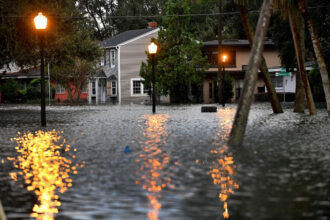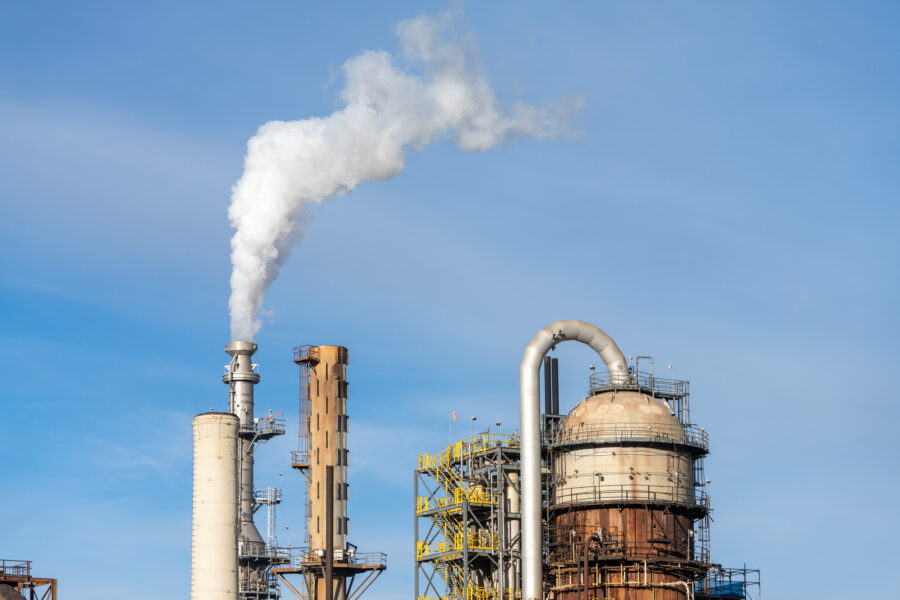Mexico anticipates exporting liquified natural gas for the first time this year. But prospects for the country’s nascent LNG industry—where each export terminal requires more than one billion dollars in investment—have cooled following the Biden administration’s pause in January on new export permits.
The Department of Energy issues permits for LNG terminals in Mexico that would re-export natural gas from the United States. On Jan. 26, the Biden administration announced a pause in pending permits for LNG export to non-free trade countries while the DOE updates its economic and environmental analyses for these projects. The move came after increasing public pressure to reject new LNG export permits in places like the Gulf Coast. The new analysis is expected later this year. Meanwhile, projects in Mexico waiting on permits, or seeking additional export capacity, are now in limbo. At least four LNG export projects on Mexico’s Pacific Coast are impacted by the pause, and another three on the Gulf Coast.
Mexico is already the biggest importer of natural gas from the U.S. If proposed LNG export facilities go forward, it could also become a major player in the global LNG market. But it remains to be seen whether additional scrutiny from U.S. regulators will scare off investors or merely slow down the rise of LNG exports from Mexico. For now, the pause is encouraging environmental advocates in Mexico who question the country’s reliance on U.S. natural gas and the climate impacts of LNG exports.
“The fact that Biden paused these projects, and that he used a climate argument to do so, is good news,” said Pablo Ramírez, a climate and energy campaigner for Greenpeace Mexico. “But we don’t know just how good that news will be for Mexico.”
Other advocates worry that natural gas export capacity will continue to rise despite the pause. Houston-based Mexico Pacific Limited’s proposed Saguaro Energía terminal would export LNG from the coast of Sonora to Asia. The facility will now face additional review as it seeks more export capacity. But in February the Federal Energy Regulatory Commission approved the pipeline that would cross from Texas into Mexico to transport gas to the proposed export facility.
“At a time when the Biden administration is saying we need to take a closer look at the public interest factors that go into these gas exports, here we have the FERC essentially ignoring that,” said Doug Hayes, a senior attorney with the Sierra Club.
Fracking Boom Fuels LNG in Mexico
The eight facilities already exporting LNG from the United States are unaffected by the recent pause. But in Mexico, the announcement comes as the country prepares to export LNG for the first time. Thanks to its proximity to the Permian Basin and other Texas oilfields, Mexico’s imports of U.S. natural gas have already skyrocketed in recent years.
The proposed LNG export projects in Mexico that have received or applied for non-free trade country export permits have a combined total capacity of 60.8 million metric tons per year, according to global ship brokerage Poten & Partners. According to industry data, the United States exported 88.9 million metric tons of LNG during 2023, an all-time high.
As fracking revolutionized the oil and gas industry, Texas produced a glut of cheap natural gas. Exporting to Mexico was a logical next step. Energy reforms in 2014 opened Mexico to more foreign investment and free trade agreements facilitated natural gas exports. Companies like TC Energy, an infrastructure company based in Calgary, formerly known as TransCanada, and Energy Transfer Partners, one of North America’s largest midstream energy companies, built an extensive network of pipelines crossing from Texas into Northern Mexico and the center of the country.
By 2022, imports from the United States met 69 percent of the demand for natural gas in Mexico, according to Mexico’s Secretary of Energy.
“Mexico has had access to a relatively stable, affordable and substantial supply of natural gas,” said Diego Rivera Rivota, a senior research associate at Columbia University’s Center on Global Energy Policy who previously worked as an advisor to Mexico’s state-owned utility. “This has been good news for Mexican users… but now we are in a situation in which Mexico is heavily dependent on these imports.”
As Mexico imported more natural gas, U.S. LNG exports from the Gulf Coast to Europe and beyond soared from 2016 on. But to reach growing markets in Asia, LNG tankers departing from the Gulf Coast had to pass through the Panama Canal. Meanwhile, efforts to build LNG export facilities on the west coast of the U.S., such as Jordan Cove on Coos Bay in Southwest Oregon, foundered.

Companies eyed Mexico’s Pacific Coast as an alternative to avoid the political logjam in the western U.S.
“Asia is the most lucrative market for these projects,” said Sergio Chapa, an LNG analyst at Poten & Partners. “And putting a project on the West Coast of Mexico means that ships don’t have to go through the Panama Canal.”
California-based Sempra Energy’s Costa Azul LNG is the most advanced of the west coast projects. The pipeline infrastructure built to provide Texas natural gas for Mexico’s domestic market would also supply the LNG export facilities.
Environmental non-profit Friends of the Earth calls Mexico’s Pacific Coast the “region most impacted by President Biden’s LNG pause” after the Gulf Coast of Texas and Louisiana.
Companies must obtain a permit from the DOE to export natural gas sourced from the United States to non-free trade agreement countries, like China, France and the United Kingdom. The pause impacts projects that require these permits or permit extensions.
Of the six proposed LNG export terminals on Mexico’s Pacific Coast and the adjoining Gulf of California, Sempra’s Costa Azul in Baja California is already under construction and unaffected by the pause. Four other projects, including a request for additional export capacity at Mexico Pacific Limited’s (MPL) Saguaro Energía at Puerto Libertad, Sonora, will be subject to additional review following the pause. A sixth facility, Vista Pacifico, has all its permits but has not attracted long-term contracts, stalling construction.
On Mexico’s Gulf Coast in Tamaulipas, New Fortress Energy’s Altamira Fast LNG, a floating LNG plant, is permitted and poised to begin exports—but it does not have authorization to export to non-free trade countries. New Fortress Energy’s land terminal in Tamaulipas and other proposed export terminals in Veracruz on Mexico’s Gulf Coast are impacted by the pause.
Poten & Partners’ Chapa said there was “an immediate reaction” in the market to the LNG pause.
“A panic, almost, about whether or not this would have a chilling effect on developers,” he said. “These are projects that have been in the works for more than a decade. And they’ve spent hundreds of millions of dollars on advancing these projects.”
Chapa said MPL’s Saguaro Energía, with a combined 30 million metric tonnes per year capacity in two phases, is a harbinger for the industry. “All eyes are on Mexico Pacific Limited right now and how they are going to respond to this situation,” he said.
MPL already has DOE approval to export 1.7 billion cubic feet per day of LNG. But that permit sets a deadline of December 2025 to begin exporting LNG. Analysts say it is unlikely MPL will be able to begin construction and start exporting that quickly. But any permit extension that MPL seeks will most likely be held up by the pause. MPL has also applied for an additional 0.79 billion cubic feet per day of capacity for the second phase of the project. That request is now paused.
“These are projects that have been in the works for more than a decade. And they’ve spent hundreds of millions of dollars on advancing these projects.”
Chapa said industry analysts are watching for when MPL seeks a permit extension and whether banks will be willing to loan the company money in the meantime.
“I think the market will have clear signals in the coming months,” said Columbia University’s Rivera Rivota. “I think, for the moment, companies are using a wait and see approach.”
MPL did not respond to a request for comment.
Pipeline to Nowhere?
MPL’s Saguaro Energía is linked with an ambitious pipeline project to supply natural gas from the Permian Basin. The 155-mile, four-foot diameter Saguaro Connector pipeline, a project of Oklahoma-based ONEOK gas provider, would run from the Waha Hub in west Texas to the U.S.-Mexico border. After crossing the Rio Grande into Mexico, it would connect to the proposed Sierra Madre pipeline, which would transverse 500 miles to the proposed export terminal in Puerto Libertad.
Communities in West Texas have spoken against the pipeline as previously reported in Inside Climate News. While the LNG export terminal is now in limbo, the Saguaro Connector pipeline continues to clear regulatory hurdles. On Feb. 15, FERC approved the permit for a 1,000-foot section of the pipeline at the international border. The rest of the pipeline is authorized by Texas regulations.

“It wasn’t a surprise at all that FERC approved the pipeline. This is basically a rubber stamp agency,” said Bill Addington, a resident of Sierra Blanca, Texas, near the route of the pipeline. “This [pipeline] does nothing but hurt the United States and it’s not in our interest.”
Sierra Club attorney Doug Hayes, who has filed motions in opposition to the permit, said that FERC should have considered the pause in its assessment of the pipeline. FERC is required to consider the “purpose and need” of projects before issuing permits.
“If that LNG terminal in Mexico isn’t authorized for the full amount, what’s the purpose and need of a 2.8 billion cubic feet … pipeline?” he said.
ONEOK has not made a final investment decision on the pipeline and company executives have previously said they are waiting for MPL to make a final investment decision on the export terminal first. At an industry conference in December, Walter Hulse III, ONEOK’s chief financial officer, said the company will not move forward with the pipeline “if we think we are in a situation where we [have] a pipe to nowhere.”
During ONEOK’s Feb. 27 earnings call, the company said it expects to make a final investment decision on the pipeline by mid-2024. Senior Vice President Charles Kelley said the company feels “pretty good” about the first two trains, or export units, of the MPL Saguaro Energía project moving forward with the existing authorization.
ONEOK did not reply to a request for comment.
The Sierra Club argued before the FERC that the agency’s permit for the Saguaro Connector pipeline should be treated as a “connected action” to the Department of Energy permit for MPL’s Saguaro Energía—and that would have triggered more thorough environmental analyses.
FERC ruled that the two permits were not connected because “the Saguaro project does not depend on MPL obtaining a DOE authorization.” The agency said that MPL could obtain natural gas from other pipelines if the Saguaro Connector is not built.
A FERC spokesperson referred to the agency’s order, which also states that because the DOE has the “sole authority” to license natural gas exports from the facility, the two permits are not connected actions.
Lukas Ross, Friends of the Earth climate and energy deputy, said that Saguaro’s approval will galvanize opponents of the LNG pause. House Republicans passed a bill to overturn the LNG pause in February. Senate Republicans have introduced a similar bill, but it is unlikely to pass the Democratically-controlled body.
“I can guarantee that as soon as the Saguaro connector gets its rubber stamp industry is going to be beating the desk even harder demanding for the pause to be lifted,” Ross said.
Without LNG exports from Mexico, existing pipeline capacity from Texas into Mexico is sufficient to supply Mexican domestic consumption. According to East Daley Analytics, pipeline capacity from the Permian Basin to Mexico is “already plentiful” and existing pipelines are being used at only 42 percent capacity.
“Without new demand sources like LNG, the Saguaro pipeline is likely unnecessary,” the analysts wrote in January.
Elections, U.S. Politics Will Shape Mexico’s Energy Sector
Both Mexico and the United States are preparing for presidential elections later this year. In Mexico, President Andrés Manuel López Obrador’s party Morena is backing former Mexico City Mayor Claudia Sheinbaum. She is heavily favored to win.
Sheinbaum, a climate scientist and former professor at the National Autonomous University of Mexico, has a strong background in environmental and climate issues compared to López Obrador, who has been criticized for backing a new oil refinery and other fossil fuel projects during his six-year term.
This story is funded by readers like you.
Our nonprofit newsroom provides award-winning climate coverage free of charge and advertising. We rely on donations from readers like you to keep going. Please donate now to support our work.
Donate NowBut environmental advocates are unsure whether Sheinbaum as president would prioritize climate and the environment.
“As the first woman president in Mexico, in such a machista culture, she would have very little room to maneuver, unlike AMLO,” said Greenpeace Mexico’s Ramírez, referring to the sitting president.
Rivera Rivota said if Mexico continues to rely on natural gas as its main power source, its leaders will have to examine how to meet greenhouse gas emissions targets. He also warned that LNG exports could eventually compete with domestic demand for natural gas in Mexico.
“Whoever is the next president [of Mexico] should take very seriously what role natural gas should have in the longer term in Mexico,” Rivera Rivota said. “If you have, say, 70 percent dependency on another country for your supply of natural gas, you’re certainly not self-sufficient.”
Advocates in the United States are counting on the additional DOE review to incorporate the impacts of LNG exports to climate change and local communities, from the Gulf Coast to the Pacific.
“At the end of the day what climate activists want is an honest approval process that actually considers the full justice and climate implications of these projects,” said Ross of Friends of the Earth.













